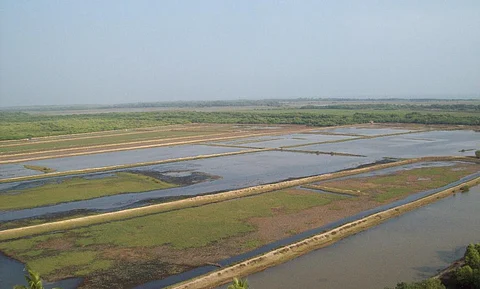

The coastal villages around Odisha’s Bhitarkanika National Park are bracing for the severe impact of Cyclone Dana, expected to make landfall between Bhitarkanika and Dhamara on October 24. The area, home to the country’s second-largest mangrove forest, has been left increasingly exposed due to the illegal clearing of mangroves by prawn farming mafias.
“Mangroves protect seaside villages from the worst effects of storms, but the extensive clearing of mangrove forests for prawn farms has made coastal pockets more vulnerable,” said Hemant Rout, an environmentalist and secretary of the Gahirmatha Marine Turtle and Mangrove Conservation Society. “Around 100,000 residents of 45 villages near Bhitarkanika are spending sleepless nights as Dana nears the coast.”
Local residents recall a time when their villages were surrounded by a “green wall” of mangroves, which served as a natural defence. “Twenty years ago, our village was covered in mangroves, but many influential figures have illegally converted these areas into prawn farms. Now we will face the full force of Cyclone Dana,” said Harish Chandra Mallick (68), a teacher from Jagatajora village.
Villagers from areas such as Rangani, Talachua, Praharajpur, and Charigharia are particularly vulnerable. Without the mangroves to act as a barrier, they fear tidal surges and saline water from the sea will inundate their homes. “Mangroves not only shield us from storms but also stabilise the shoreline. Without them, we will bear the full onslaught of the tidal waves,” said Prabir Mandal, a farmer from Rangani village.
The fear stands in stark contrast to those who live in mangrove-protected areas. ”We are not worried about Dana because our village is surrounded by dense mangrove forest,” said Nakula Behera from Iswarapur village in the park.
For many, the disappearance of the mangrove cover evokes painful memories of past cyclones. “Our village survived the 1999 Super Cyclone because of the mangroves. Now, with thousands of trees felled by prawn mafias, we are terrified of what Dana will do,” said Biswanath Jena (59) from Ajagarapatia village.
Bhitarkanika National Park, which spans 145 square kilometres, and the adjacent Bhitarkanika Wildlife Sanctuary, covering 673 square kilometres are spread over Rajnagar, Rajkanika and Mahakalapada blocks of Kendrapada district.
Earlier this year, the Union Ministry of Environment, Forests and Climate Change unveiled a draft notification for an eco-sensitive zone around the park, intended to protect 209 nearby villages. Around 275,000 people live near Bhitarkanika National Park and its surrounding areas.
“We have taken action against prawn mafias, dismantling around 400 acres of illegal prawn farms this year," said Manas Das, assistant chief conservator of Bhitarkanika National Park. However, the illegal conversion of forests into prawn farms continues to pose a threat.
Prawn farming not only depletes the region’s mangrove cover but also introduces harmful chemicals into the environment. The toxic residues used in aquaculture to control parasites have polluted groundwater and farmland, said environmentalist Biswajit Mohanty, secretary of the Wildlife Society of Odisha.
“Most of the prawn farms violate the Coastal Regulation Zone and Supreme Court rulings. Farmers operating without registration with the Coastal Aquaculture Authority can face penalties, including imprisonment and a fine of up to Rs 1 lakh,” Mohanty stated.
Despite long-standing recommendations, there have been little efforts to protect the coastline. “A committee chaired by P Koteswaram, the-then Director General of Observatories and the head of India Meteorological Department, was set up to explore measures for minimising loss of life and property during future cyclones,” said Umesh Chandra Singh, president of the district unit of Krishak Sabha.
In 1971, the panel gave 59 recommendations, including suggestions for coastal embankments can be constructed along areas prone to tidal inundation, accompanied by afforestation extending approximately 1 km inland. This forest cover would serve as a windbreaker and help prevent soil erosion. “Little was done,” said Singh. Now, as Dana approaches, the residents of Bhitarkanika face an uncertain and perilous future.